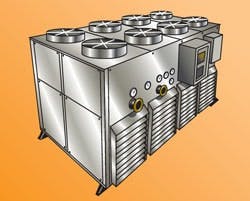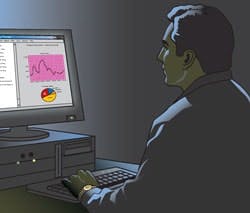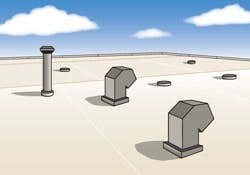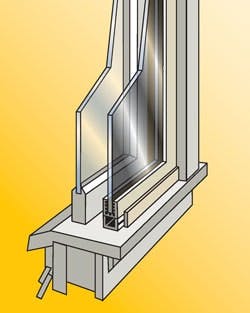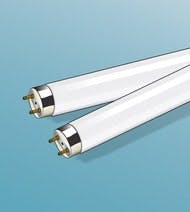Energy Management: Tips to Increase Efficiency
It’s a classic conundrum: A sudden rise in energy costs is wreaking havoc on your operating budget. What do you do? Smart facilities professionals are scrutinizing equipment purchases, retrofitting outdated systems, and implementing proactive maintenance programs to conserve not just energy, but money, too. Energy management doesn’t begin and end with the selection of efficient systems. As you’ll learn on the following pages, it takes both wise purchasing and maintenance to really dial down energy consumption - and a little upgrading or retrofitting along the way doesn’t hurt, either.
| HVAC |
Constructing
When a new construction project is under design, the factors that influence load on the HVAC system should be considered. “The design stage of a project offers several opportunities for energy efficiency and minimization of the amount of energy required by the HVAC systems,” explains Lisa Raffin, vice president, professional services, VFA, Boston. The orientation of a building on the site, the type of glazing used, the amount of insulation, the quantity of outdoor air introduced into the building, as well as the type of lighting systems employed will all impact the demand for heating, cooling, and ventilation. Work closely and discuss options with architects, engineers, and other building-team members.
Making purchasing decisions isn’t easy. Use ratings and standards to help judge a product or system’s efficiency. “Buildings and their components should, at a minimum, meet the requirements of ANSI/IESNA/ASHRAE Standard 90.1-2004,” says Andrew Wilcox, global marketing manager, Trane Control Systems, St. Paul, MN. Other considerations include compliance with Energy Star®, LEED, or the New Buildings Institute’s standards and documents.
Additionally, make sure to “right-size” HVAC systems. “Greatly oversized equipment operates less efficiently and costs more than properly sized equipment,” explains Carl Ian Graham of Steven Winter Associates in High-Performance HVAC, a resource provided by the Whole Building Design Guide. Raffin offers the following advice:
- Depending on the size of the building, the use of a chiller rather than packaged rooftop units may be an energy-efficient alternative. Typically, the chilled water system has a much lower kW/ton of cooling when compared to packaged or “split systems.”
- If chillers don’t make sense, packaged rooftop units with scroll (rather than reciprocating) refrigerant compressors may be considered. These units usually have increased condenser bundle sizes as well, which also improves efficiency.
- A Variable Air Volume system (rather than a Constant Air Volume system) uses less fan energy. In this case, a Variable Frequency Drive should be used in lieu of inlet guide vanes.
- Direct Digital Control systems offer increased accuracy and the ability for the buildings’ systems to be computer controlled. Increased energy efficiency will result with the proper control strategies and a properly commissioned system.
Once the equipment is installed, it’s critical that you ensure proper operation. “Commissioning is the process of ensuring that the building systems are designed, installed, functionally tested, and capable of being operated according to the owner’s operational needs,” explains Raffin.
MODERNIZING and MAINTAINING
The only way to ensure that the energy-efficient equipment you’ve installed is running at its optimum level is maintenance. Develop a routine schedule for inspections, cleaning, and filter changes. “Follow the recommendations of the manufacturers of the equipment [and perform the] annual periodic maintenance that’s required for each system. At a minimum, you should be doing preventive maintenance at least twice a year - once at the beginning of the cooling season and once at the beginning of the heating season,” explains Stephen R. Yurek, general counsel, vice president, policy and public affairs, Air-Conditioning and Refrigeration Institute, Arlington, VA. Keep a log documenting the equipment’s performance to help diagnose long-term problems.
To determine the opportunity for energy savings and develop a stronger understanding of the equipment currently being operated, consider calling on a certified professional to perform a facility assessment. “Survey data normally includes the age, capacity, condition, and expected useful life of the mechanical and electrical equipment. For the purpose of energy conservation, this information is reviewed to determine if opportunities exist to make repairs or enhancements to the existing equipment or control systems,” says Raffin. An assessment can help you determine where capital can best be spent to reap the greatest operating efficiency.
Other strategies to save money and energy are the result of decreasing load. Consider implementing a program to reduce the amount of energy consumed during peak hours. Otherwise, add thermal storage capability to your chiller so that you can take advantage of better time-of-use rates from the utility; if rebates are available, the cost of implementation is greatly reduced. Perform an energy audit. Implement a strategy or install controls to reduce the likelihood of conditioning unoccupied or unused spaces. A building automation system can help. Additionally, retro-commissioning can determine the performance and efficiency of aging equipment.
| Building Automation Systems |
- Chiller/tower optimization. A BAS calculates the cooling tower setpoint to minimize the sum of the chiller plus tower energy consumption, and reduces 5 to 7 percent of the chiller/tower energy.
- Variable flow pump pressure optimization. A BAS reduces pump energy consumption by resetting the pump pressure control setpoint to a minimum as indicated by the position of the “critical” chilled water system control valve. It can reduce 20 to 45 percent of the pumping system energy.
- VAV fan pressure optimization. Building controls reduce fan energy consumption by resetting the fan pressure control setpoint to a minimum as indicated by the position of the “critical” damper, reducing 20 to 45 percent of the fan system energy.
- Ventilation reset. A BAS dynamically monitors the outdoor air fraction of each zone, calculates the minimum outdoor airflow rate that meets the ventilation requirements of each system, and resets the outdoor air dampers to bring in the proper ventilation airflow, which reduces up to 25 percent of energy used by the HVAC system.
When purchasing a BAS, make sure the company offering the solution has a solid understanding of the HVAC components being installed in the building. Wilcox cautions: “Facility managers and building owners should look for a supplier with experience in both controls and HVAC to have the application knowledge to effectively implement these energy-saving strategies.”
HVAC is not the only equipment that can interface to a BAS. Security and life-safety equipment, as well as lighting systems and vertical transportation, can be tied in and programmed to provide an automatic sequence of events when the building is occupied. Rick LeBlanc, senior vice president and division head, building automation division, Siemens Building Technologies Inc., Buffalo Grove, IL, explains: “If you use your access-control card to go into a certain area of the building, the building automation system will turn on the air-conditioning and the lighting system. When the building is unoccupied, the building automation system can shut down or run on a night setback mode. When the first occupant comes in, that system re-energizes itself, thereby saving energy in an unoccupied period.”
MODERNIZING and MAINTAINING
BASs have changed tremendously since the early days of pneumatic controls. If your current system has limited capabilities, consider approaching the manufacturer to ask about upgrades. If you’ve decided it’s worth the investment to buy a new system, discuss with the supplier how their products will be compatible with future technology. “A service contract on a BAS can help ensure the system is functioning per the design and working as effectively as when it was commissioned,” explains Wilcox. “A BAS service contract can keep software and hardware up to date with predictable expenses.” Additionally, it’s important to make sure the systems controlled by the BAS are operating properly. “The equipment that is being controlled also needs to be maintained,” says LeBlanc. “The more advanced automation systems can predict and monitor whether those systems are operating in the peak range of their efficiency.”
| Roofing |
While the roof might not be one of the first building systems to come to mind when prioritizing how to reduce energy consumption, wise choices in roofing product selection can significantly reduce heating and air-conditioning loads. The level of insulation applied and the surface’s reflectivity will greatly impact heat loss or gain. How a cool roof works is relatively simple. It reflects the sun’s ultraviolet rays rather than absorbing them - thereby, reducing the amount of heat penetrating into the building and the level of air-conditioning required. According to ENERGY STAR®, reflective roof products can decrease the amount of air-conditioning needed in buildings and peak cooling demand by 10 to 15 percent.
When comparing various roof systems, turn to the Oakland, CA-based Cool Roof Rating Council (www.coolroofs.org) and ask manufacturers about reflectivity and emissivity ratings. All low-slope, Energy Star-labeled roofs are required to have a minimum solar reflectivity of at least 65 percent, with an aged value of 50 percent. Reflectivity can also be expressed by a number between 0 and 1; the closer the value is to 1 (or the higher the percentage), the greater the reflectivity. High emissivity may or may not be another important product attribute to consider, depending on the climate zone. Emissivity is the measure of a material’s ability to emit heat. It, too, is expressed by a number between 0 and 1, with higher numbers indicating faster heat transfer.
According to the Chemical Fabrics and Film Association’s Vinyl Roofing Division in the Vinyl Roofing as a Cool Roofing Solution white paper, “There are several ways to attain the benefits of a cool roofing system. They range from short-term solutions (such as paints and coatings that can temporarily turn dark roofs white) to long-term waterproofing solutions (such as highly reflective white or light-colored single-ply vinyl membranes). Green, or planted, roof systems also fall into this category.” Not all systems that deliver high reflectivity are white single-ply membranes. The recent introduction of new pigments has enabled even painted metal roofing systems to offer greater reflectance levels. “I think you’ll see more and more of the modified bitumen manufacturers coming out with ENERGY STAR-rated surfaces on their products, such as a highly reflective granule or a coating that is preapplied at the manufacturing plant,” adds Gary R. Cattel, president, Roof Engineering Inc., Raleigh, NC.
MODERNIZING and MAINTAINING
Re-roofing offers the ideal time to add insulation and a cool roof. However, your 5-year-old roof may be performing well despite its inability to reflect the sun’s ultraviolet rays. A tear-off isn’t justifiable, but the application of a white or light roof coating might be. Acrylic or elastomeric coatings contain white pigments to boost reflectance and can be ideal for built-up and modified bitumen roofing systems. In addition to increasing reflectivity, coatings enhance the performance of the roof system by extending its life. “It should enhance performance, because now you’re restricting moisture contact with the membrane and you are also reducing the thermal load and solar degradation of a built-up roof,” Cattel explains. Another method for increasing reflectivity on a dark-surfaced modified bitumen roof is adding white or light-colored ballast.
| Insulation |
When undertaking a new construction project, your options are to meet code or exceed it. If you choose the latter, you’re probably in the minority - but as energy prices continue to soar, the decision to spend more upfront will result in less painful utility bills in the future. “Remember, the code is the legal minimum,” says Jared O. Blum, president, Polyisocyanurate Insulation Manufacturers Association (PIMA), Alexandria, VA. “One of the mistakes that is made in the building community is the feeling that [the minimum] is all we need to do.”
To justify higher initial costs, use any number of modeling programs to calculate the level of insulation and envelope enhancements that can result in reduced energy. Software like Energy-10, an energy simulation tool for buildings offered by the Sustainable Buildings Industry Council, estimates the payback for a variety of sustainable design strategies. This is just one of many programs available.
Because buildings with increased thermal performance reduce the amount of outside air penetrating in and the level of conditioned (warm and cool) air escaping, HVAC systems won’t have to work as hard to maintain a comfortable interior environment. The money saved by downsizing this equipment can help offset the increased costs of installing insulation that has a greater R-value than what codes mandate.
MODERNIZING and MAINTAINING
A major modernization project provides the perfect opportunity to increase the R-value of an existing building’s insulation. If a gut-rehab isn’t on the planning boards, consider your next re-roofing project as the ideal time to apply insulation to minimize air leakage and infiltration. Improper installation of roof insulation (often in the form of rigid board stock) can compromise thermal performance. Ask your roofing contractor or consultant how they plan to reduce the likelihood of thermal bridging (when conditioned air escapes through joints in the insulation board).
While maintaining insulation might seem like the easiest task on your to-do list, it’s imperative that the building envelope be monitored closely for water penetration. Any leaks in the façade or roof will compromise the thermal value of the building’s insulation.
| Windows |
Window-laden buildings maximize the opportunity to use daylight as opposed to electric lighting, thereby saving energy. However, if inefficient windows are selected, the savings reaped from less lighting will be minimal in comparison to the increased heating and cooling required. According to the Washington, D.C.-based Alliance to Save Energy: “Today’s high-efficiency windows are 40-percent more energy efficient than standard, less-efficient ones and can improve heating and cooling energy savings by some 15 percent.” To select the most efficient product for your new building, learn the terminology. The Portland, OR-based Northwest Energy Efficiency Alliance’s Commercial Windows Initiative provides the following definitions in its Designer’s Guide for Energy-Efficient Commercial Windows:
- U-Factor. The lower the U-Factor, the greater the window’s resistance to heat flow and the better its insulation value.
- Solar Heat Gain Coefficient (SHGC). The fraction of solar radiation, or short-wave infrared rays, admitted through a window or skylight. The lower a window’s SHGC, the less solar heat it transmits.
- Low-E. Microscopically thin, virtually invisible metal or metallic oxide layers deposited on the glass in a window or skylight. Low-E coatings reduce the heat transfer between the layers of glass.
- Low Solar Heat Gain Low-E Coatings. These are low-E coatings that let the visible daylight in and reflect the harmful ultraviolet and infrared out. Because these coatings have low emissivity, they provide an added layer of insulation as well.
- Visible Light Transmittance (VT). The percentage of visible light that comes through the window.
- Argon Gas. An inert, non-toxic gas used to insulate windows in order to reduce heat transfer.
To discern which windows are appropriate for your facility and geography, look for ENERGY STAR® windows and review the product’s NFRC (National Fenestration Rating Council) label. This will indicate the window’s performance capabilities by revealing U-Factor, SHGC, VT, and Air Leakage ratings. Where your building is located (i.e. the climate zone) will influence the ratings you seek. For example, a facility in northern Minnesota should have windows with a U-Factor of 0.35 or less, whereas a building in the Florida Keys requires a U-Factor of 0.65 or less.
Double-pane (or double-glazed) windows feature an air space, which serves as insulation, between the layers of glass and offers excellent energy performance. When paired with other desired attributes, these windows offer very realizable energy savings. “Energy-efficient windows with low-E coating can reduce heating bills by 34 percent in cold climates compared to uncoated, single-pane windows. In hot climates, spectrally selective low-E windows can cut cooling costs by 38 percent,” explains the Alliance to Save Energy.
MODERNIZING and MAINTAINING
Replacing inefficient windows can be extremely costly, time-consuming, and a real inconvenience to building occupants. If your budget or your tenants are not in favor of new windows, consider film. “Window films are designed to - depending on which product you pick - stop anywhere from 30 percent up to 83 percent of the total solar energy that strikes the window,” says Darrell Smith, executive director, Intl. Window Film Association (IWFA), Martinsville, VA. The use of window film results in an immediate decrease in the cooling load; as an additional benefit, many utility companies provide rebates and incentives to help pay for the retrofit.
Keeping your energy-efficiency goals in mind, look at the film’s shading coefficient, defined by IWFA as the ratio of solar heat gain passing through a glazing system to the solar heat gain that occurs under the same conditions if the window were made of clear, unshaded window glass. The lower the number, the better. “An average window film would have a shading coefficient in the neighborhood of 0.45 to 0.55,” says Smith. In many applications, window film can help you meet the U-Factor and Solar Heat Gain Coefficient ratings mandated by current building codes - and sometimes can even exceed the building code requirements for new windows.
When selecting the right window film for your application, consider how the climate will affect the product’s performance. Smith provides the following example: “In Denver, there is a lot of sunshine, so you have a lot of solar [heat] gain in a building. You may have a high air-conditioning bill or a summer peak-demand problem. There, you would want a fairly reflective type of film or window. However, during the winter, there’s some ‘free heat’ you would be losing by rejecting some of that solar energy. By installing the same film in a low-E version, the reduction in heat loss during the winter would offset the loss of free heat. During the winter it might be energy neutral, but during the summer you’re reducing the energy need because you’re reducing the air-conditioning load.”
| Lighting |
Lighting design is critical to energy management. If your design does not provide adequate lighting for the tasks being performed, users are likely to bring in their own light sources (typically inefficient incandescent lamps). Work closely with a lighting consultant or designer to establish how best to light the space for occupant comfort, aesthetics, and energy efficiency. These professionals can provide advice on which lamps, ballasts, fixtures, and controls will help you meet your energy management goals as well.
MODERNIZING and MAINTAINING
If you’re still operating T12 lamps and magnetic ballasts, the potential savings reaped through retrofit are significant. “Recently developed energy-efficient lighting equipment, such as compact fluorescent lamps and ‘soft-start’ electronic ballasts, can be used to help cut lighting operational costs by 30 to 60 percent while enhancing lighting quality, reducing environmental impacts, and promoting health and worker productivity,” says David Nelson of David Nelson & Associates in Energy Efficient Lighting, a resource provided by the Whole Building Design Guide.
To increase the efficiency of existing equipment, institute a routine maintenance plan. If lighting controls are already in use, it’s imperative that sensors be recalibrated, routine maintenance be performed, and commissioning occur. Malfunctioning controls can actually increase energy consumption and lighting costs.
To trim expenses even more, concentrate efforts on conservation. “Utilities have been running demand-side management and conservation programs since the early 1990s,” says Leslie. Available rebates and incentives can help justify the cost of new equipment like electronic ballasts. Dimming lights during peak hours reduces watts - and costs. “Lighting can easily be reduced for several hours by 30 percent with most people not noticing. It can be dimmed even more if you tell people the reason why you’re doing it,” he explains. This will help reduce the demand for power when utilities are reaching peak capacity. A new device (currently being developed) called a “load-shed ballast” will allow this step dimming to occur automatically and inexpensively.
To determine the potential savings of installing new equipment, run an analysis using some of the calculators provided online by manufacturers. Examine how, when, and where lighting is being used and install occupancy sensors and time controls so that unused and unoccupied spaces are not being lit continuously.
Your energy management goals should extend beyond interior ambient lighting to include exterior and parking-lot lighting as well. The Pennsylvania Department of Environmental Protection explains the potential for savings: “A fixture using an efficient 180-watt low-pressure sodium lamp will consume approximately $70 of electricity per year at $0.08 per kilowatt hour. An inefficient 700-watt mercury vapor lamp would consume $250 of electricity. Both lamps produce roughly the same amount of light.” The department recommends using low-pressure sodium, high-pressure sodium, and metal halide lamps to create a quality, safe, and efficient outdoor lighting environment.
Jana J. Madsen ([email protected]) is managing editor at Buildings magazine.

